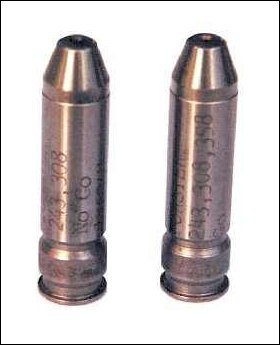Go /No-go Gauge
This is what a set of .308
Winchester Go/No-go gauges look like. They are designed to
verify that chamber headspace is within the SAAMI spec tolerance from
the base of a case to its shoulder. It's best to use them after
removing the ejector on most rifles, so that you can "feel" these
gauges as they are chambered.  These gauges help you verify that any factory loads should fit in your chamber, and be safe to fire.
These gauges help you verify that any factory loads should fit in your chamber, and be safe to fire.
When reloading, it is important to always bump the shoulder of your cases back at
least .001" - .002"
to ensure a reliable fit in your chamber. There is no accuracy
gained by crushing a cartridge into your chamber. This affects
the concentric alignment in a negative way, and it can wear the lugs of
your bolt. Keep in mind that most necked cases are tapered, and
the wall of your case should never press against the chamber.
Not all chamber reamers are perfect; and as they begin to wear out, they will cut tighter
chambers. A set of these Go /No-go gauges will rarely detect the work from a defective or worn
chamber reamer. This is because headspace gauges can't check the width of a chamber.
I have examined custom chambers that checked out
perfectly fine with Go /No-go gauges, but these chambers had
"excessively" tight body diameter. Match chambers are always a
bit tighter at the neck and usually require handloaders to do some neck
turning, but the rare tight chambers I'm referring to were actually too
tight (diameter) at the body. In some cases they caused
cartridges to jam tight against the chamber wall and fail to chamber.
The case width problem is commonly overlooked. Handloaders often find that belted magnum calibers seem to have the most case width problems, but that's caused by a different situation. It's partly due to the limitation of conventional resizing dies when handloading a case with a belt. Just keep in mind that a Go /No-go gauge is only designed to detect headspace (length) problems, and remember that "case width" is also an important consideration.
